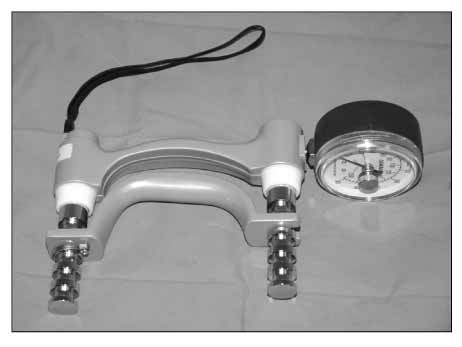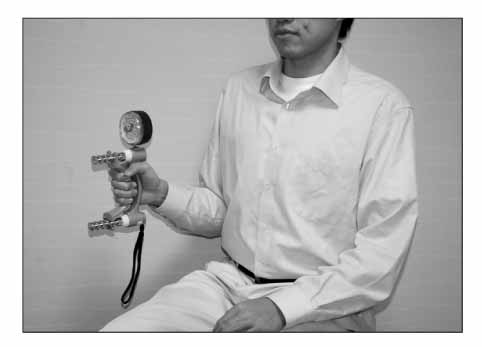J Korean Orthop Assoc.
2009 Apr;44(2):219-225.
Analysis of Grip and Pinch Strength in Korean People
- Affiliations
-
- 1Department of Orthopaedic Surgery, Bundang CHA Hospital, College of Medicine, Pochon CHA University, Seongnam, Korea.
- 2Department of Orthopaedic Surgery, Gumi CHA Hospital, College of Medicine, Pochon CHA University, Gumi, Korea. hsoohong@hanmail.net
Abstract
- PURPOSE
We wanted to investigate the grip and pinch strength of hands and establish the clinical normative data for Korean people. MATERIALS AND METHODS: A sample of 234 Korean males and 281 Korean females (age: 10 to 84) were tested. Grip strength and pinch strength were tested twice with 5 minute interval between tests. RESULTS: Generally, hand strength peaked at 30 to 39 of age for both males and females. The average grip strength was 48.8 kg for males and 28.23 kg for females and they were 11% stronger than 12 years before in both groups. Tip pinch strength peaked in the forties, but key pinch and tripod pinch peaked in the thirties. All the peak hand strength was obtained in the 30 to 39 age group of females. Among the pinch strengths, key pinch was the strongest. For the right-handed people, the grip and pinch strengths of the right hand were stronger than those of the left hand. However, for the left-handed people, the left hand was stronger than the right hand only for the tripod pinch (p<0.005). CONCLUSION: The hand strength of Koreans peaked in the 30 to 39 age group. Key pinch was the strongest among the three pinch strengths. Right-handed people have a stronger right hand than the left hand, but the left-handed people have almost the same hand strength in both hands, except for the tripod pinch.
Figure
Reference
-
1. Bechtol CO. Grip test; the use of a dynamometer with adjustable hand spacings. J Bone Joint Surg Am. 1954. 36:820–824.2. Bland JM, Altman DG. Statistical methods for assessing agreement between two methods of clinical measurement. Lancet. 1986. 1:307–310.
Article3. Bohannon RW, Andrews AW. Accuracy of spring and strain gauge hand-held dynamometers. J Orthop Sports Phys Ther. 1989. 10:323–325.4. Crosby CA, Wehbé MA, Mawr B. Hand strength: normative values. J Hand Surg AM. 1994. 19:665–670.
Article5. Fess EE. Casanova JS, editor. Grip strength. Clinical assessment recommendations. 1992. 2nd ed. Chicago: American Society of Hand Therapists;41–45.6. Firrell JC, Crain GM. Which setting of the dynamometer provides maximal grip strength? J Hand Surg Am. 1996. 21:397–401.
Article7. Hamilton A, Balnave R, Adams R. Grip strength testing reliability. J Hand Ther. 1994. 7:163–170.
Article8. Härkönen R, Harju R, Alaranta H. Accuracy of the Jamar dynamometer. J Hand Ther. 1993. 6:259–262.
Article9. Incel NA, Ceceli E, Durukan PB, Erdem HR, Yorgancioglu ZR. Grip strength: effect of hand dominance. Singapore Med J. 2002. 43:234–237.10. Lagerström C, Nordgren B. On the reliability and usefulness of methods for grip strength measurement. Scand J Rehabil Med. 1998. 30:113–119.11. Lee KS, Woo KJ, Shim JH, Lee GH. The clinical study of grip and pinch strength in normal Korean adult. J Korean Orthop Assoc. 1995. 30:1589–1597.
Article12. Massy-Westropp N, Rankin W, Ahern M, Krishnan J, Hearn TC. Measuring grip strength in normal adults: reference ranges and a comparison of electronic and hydraulic instruments. J Hand Surg. 2004. 29:514–519.
Article13. Moon MS, Ok IY, Kim HJ, Im S. The study of pinching type and power. J Korean Orthop Assoc. 1982. 17:206–212.14. Petersen P, Petrick M, Connor H, Conklin D. Grip strength and hand dominance: challenging the 10% rule. Am J Occup Ther. 1989. 43:444–447.
Article15. Pryce JC. The wrist position between neutral and ulnar deviation that facilitates maximum power grip stength. J Biomech. 1980. 13:505–511.16. Richards LG. Posture effects on grip strength. Arch Phys Med Rehabil. 1997. 78:1154–1156.
Article17. Schmidt RT, Toews JV. Grip strength as measured by the Jamar dynamometer. Arch Phys Med Rehabil. 1970. 51:321–327.18. Schreuders TA, Roebroeck M, Van DK, Soeters JN, Hovius SE, Stam HJ. Strength of the intrinsic muscles of the hand measured with a hand-held dynamometer: reliability in patients with ulnar and median nerve paralysis. J Hand Surg Br. 2000. 25:560–565.
Article19. Hazelton FT, Smidt GL, Flatt AE, Stephens RI. The influence of wrist position on the force produced by the finger flexors. J Biomech. 1975. 8:301–306.
Article20. Teraoka T. Studies on the peculiarity of grip strength in relation to body positions and aging. Kobe J Med Sci. 1979. 25:1–17.21. Young VL, Kraemer BA, Gould RB, Nemergut L, Pellowsky M. Fluctuation in grip and pinch strength among normal subjects. J Hand Surg Am. 1989. 14:125–129.
Article22. Mathiowetz V, Kashman N, Volland G, Weber K, Dowe M, Rogers S. Grip and pinch strength: normative data for adults. Arch Phys Med Rehabil. 1985. 66:69–74.
- Full Text Links
- Actions
-
Cited
- CITED
-
- Close
- Share
- Similar articles
-
- Pressure Threshold, Grip and Pinch Strength in Female Telephone Operators
- The Clinical Study of Grip and Pinch Strength in Normal Korean Adult
- Relationship Between Grip and Pinch Strength and Activities of Daily Living in Stroke Patients
- Reliability of the Pinch Strength with Digitalized Pinch Dynamometer
- Normative Data and Developmental Characteristics of Hand Function for Elementary School Children in Suwon Area of Korea: Grip, Pinch and Dexterity Study





